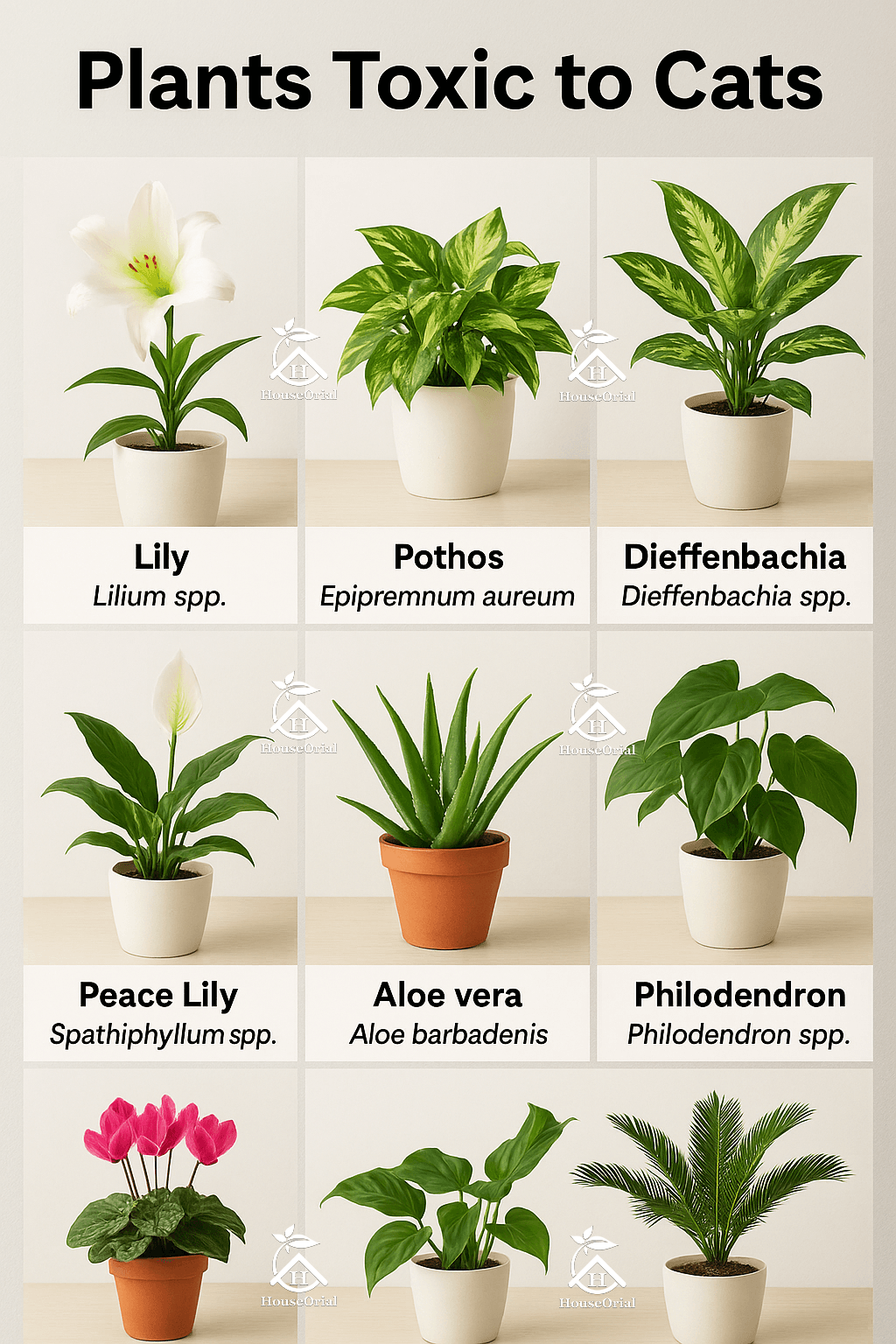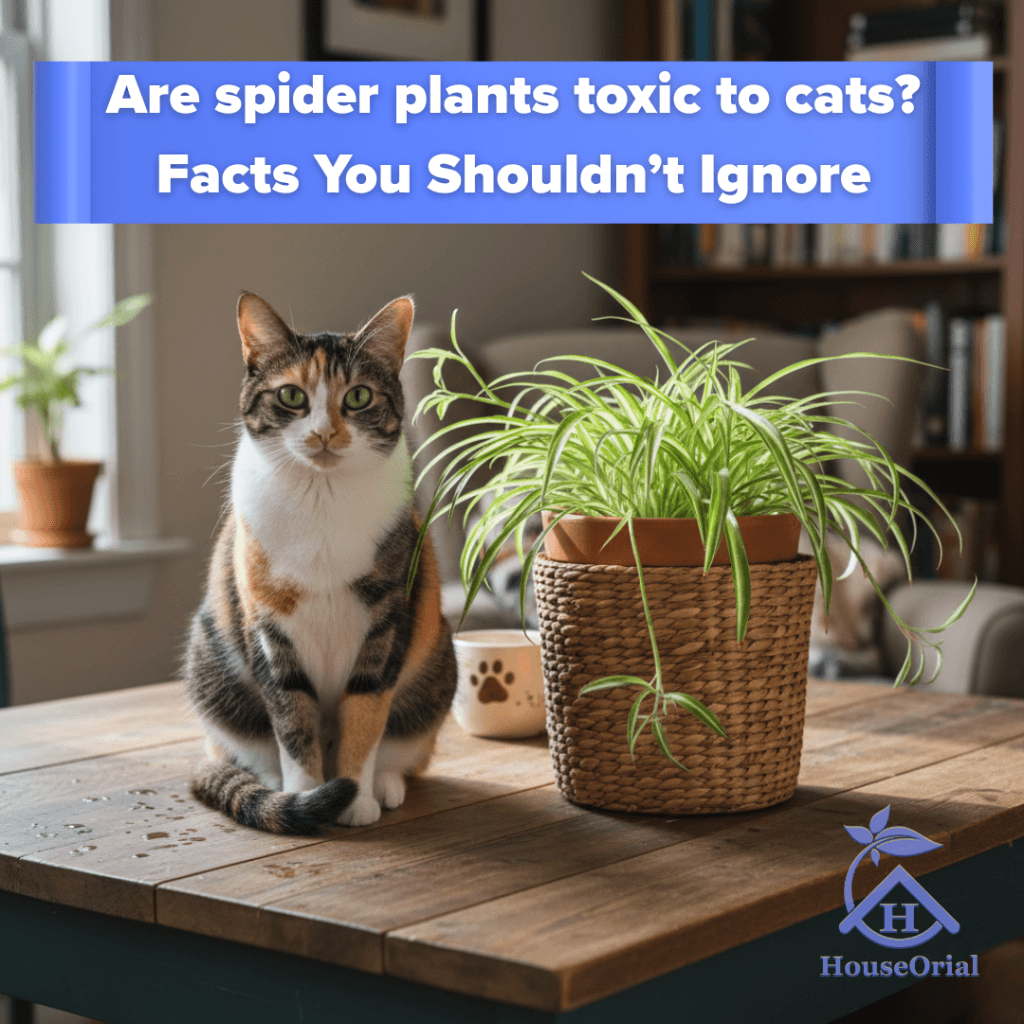Spider plants (Chlorophytum comosum) are one of the most popular houseplants. They are easy to care for. A NASA air purifier study found that spider plants can purify the air. But if you are a cat parent, you may be wondering: Are spider plants toxic to cats? The good news is that spider plants are non-toxic to cats. According to the ASPCA (American Society for the Prevention of Cruelty to Animals) and the Pet Poison Helpline, spider plants are 100% safe for cats and dogs. However, if your curious kitty eats too much of them, they can cause mild problems. Read on to find out why your cat loves your spider plant and what precautions you should still take:
Table of Contents
Check out our guide: 16 Toxic House plants to Humans That Can Cause Serious Harm
Top 10 Indoor Plants for a Healthy Home
What Happens If Your Cat Eats Too Much Spider Plant?
Cats are naturally curious creatures. Sometimes, they don’t just sniff the plant—they chew it! Although spider plants are not poisonous, eating spider plant leaves in excess can cause your cat to have an upset stomach. This is because spider plants contain mild chemical compounds that act like natural tranquilizers or hallucinogens. This reaction is similar to the effects of catnip on cats. These compounds are not toxic, but they can upset your cat’s stomach for a short time.
Note: If your kitty munches on a lot of spider plant leaves, you might notice:
1. Mild vomiting.
2. Soft stool or diarrhea.
3. Slight loss of appetite or temporary lethargy.
These symptoms are not serious and usually go away within 12-24 hours. Most cats recover quickly without any treatment.
However, if your cat continues to vomit, refuses food for more than a day, or seems unusually tired, it’s a good idea to call your veterinarian. Sometimes, excess plant fiber can cause minor intestinal discomfort that requires gentle care.
Why Do Cats Love Spider Plants So Much?
Cats are naturally curious. If you’ve noticed your cat eating the leaves of the plant, this behavior is completely normal. There are a few reasons why cats are drawn to spider plants:
1. The long, arched leaves of the spider plant sway easily with the slightest breeze or touch. To a cat, this motion mimics the movement of prey such as insects or small animals, which triggers their hunting instincts.
2. Spider plants contain natural compounds like catnip (nepetalactone). These compounds can induce mild feelings of joy or excitement in cats. This can lead to playful, hyperactive, or exploratory behavior. But don’t worry—it’s completely safe, unlike poisonous plants.
3. Cats explore the world using their mouths and paws, and the smooth, flexible leaves of spider plants provide a satisfying texture to chew on or paw at. This isn’t just play—it’s part of exploring their environment.
In short, your cat isn’t being mischievous. It’s simply responding to the plant in a natural, instinctive way. While this interaction is usually harmless, safer alternatives like cat grass can keep both your pet and your plant happy.
Ways to Keep Cats Away from Spider Plants
Although spider plants are not harmful, it is still best to keep them out of reach. Here are some simple tips:
1. Hang them up: Use hanging planters or high shelves for spider plants. This will keep your cat from reaching the leaves.
2. Use citrus scents: Cats dislike citrus smells. A light lemon or orange spray near the plant may discourage them.
3. Alternative suggestion: Plant cat grass (such as wheat grass or oat grass). These are safe and satisfying for cats to chew on.
4. Keep them busy: Entertain your cat with toys or scratching posts.
10 Cat-Safe Plants for a Pet-Friendly Indoor Garden
If you want to create a lush, pet-friendly indoor garden, here are 10 safe and easy-to-care-for plant options:
- Cast Iron Plant – Chlorophytum comosum
- Areca Palm – Dypsis lutescens
- Boston Fern – Nephrolepis exaltata
- Money Tree – Pachira aquatica
- Calathea – Calathea spp.
- Ponytail Palm – Beaucarnea recurvata
- Bamboo Palm – Chamaedorea seifrizii
- Haworthia – Haworthia spp.
- Parlor Palm – Chamaedorea elegans
- Cat Grass (Wheatgrass) – Triticum aestivum
These plants are low-maintenance and ideal for beginners, making them perfect for busy households. Best of all, they are 100% safe for cats.

Pay attention to how your cat interacts with plants. Provide safe alternatives, such as cat grass, which will satisfy their natural chewing instincts. This will keep your indoor garden intact and your cat safe to play with.
Avoid These Plants: Toxic to Cats
While many houseplants are safe for your feline friends, some common indoor plants can be harmful or even deadly if ingested. It’s important to keep these out of your home or place them well out of reach of your cat.
Here’s a list of some plants toxic to cats:
Lily (Lilium spp.) – This is one of the most dangerous plants for cats. Even small amounts can cause kidney failure.
Pothos / Devil’s Ivy (Epipremnum aureum) – Eating the leaves can cause irritation in the mouth, vomiting, and difficulty swallowing.
Dieffenbachia / Dumb Cane (Dieffenbachia spp.) – Chewing on the leaves can cause irritation in the mouth, salivation, and difficulty swallowing.
Peace Lily (Spathiphyllum spp.) – Although beautiful, it is poisonous to cats. Eating its leaves can cause irritation in the mouth, vomiting, and discomfort in the throat.
Aloe vera (Aloe barbadensis) – While beneficial to us for medical purposes, it can cause vomiting, diarrhea, and lethargy in cats.
Philodendron (Philodendron spp.) – Can cause irritation to the mouth, throat, and digestive tract.
Cyclamen (Cyclamen spp.) – Its roots are particularly toxic. Ingestion can cause severe vomiting.
Sago palm (Cycas revoluta) – This is extremely dangerous for cats. Even small amounts can cause liver damage and even death.
Note: Always research new plants before bringing them home, and place any potentially toxic plants out of your cat’s reach.

Are Spider Plants Toxic to Cats?
Spider plants are completely safe and non-toxic for cats. It’s normal for your feline friend to occasionally nibble on the leaves, as this behavior is part of their natural curiosity and playfulness. However, eating too many leaves at once can cause mild stomach upset, so it’s best to place your spider plant out of easy reach to keep both your cat and your plant happy.








